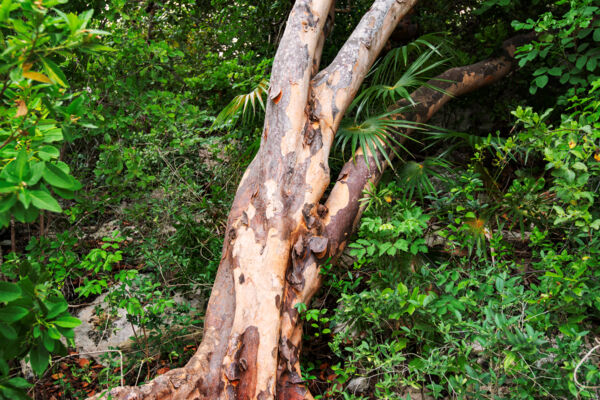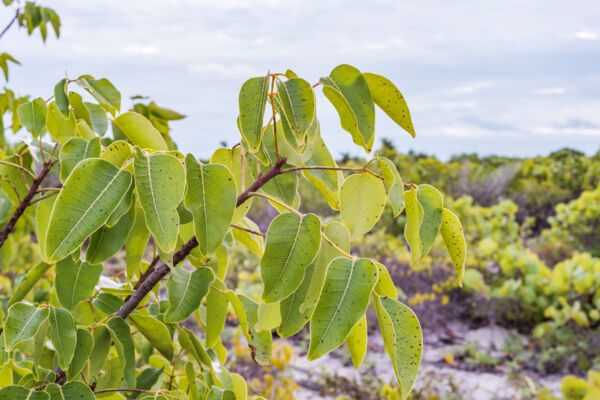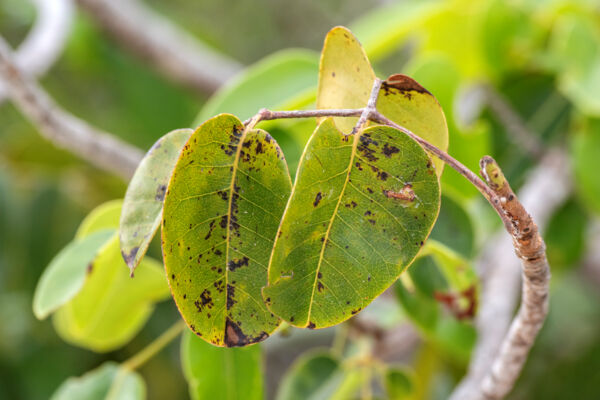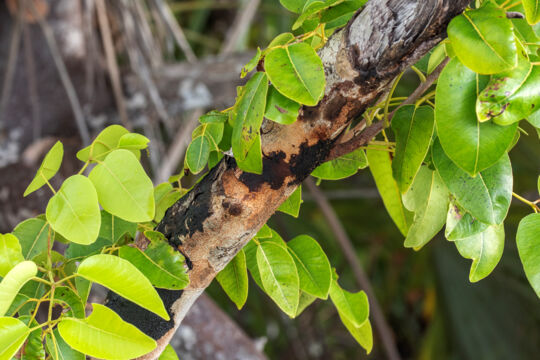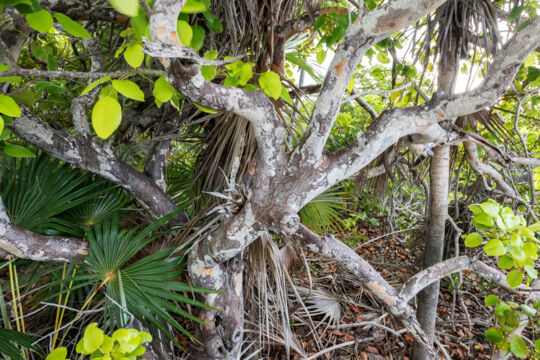Coral Sumac and Poisonwood in the Turks and Caicos
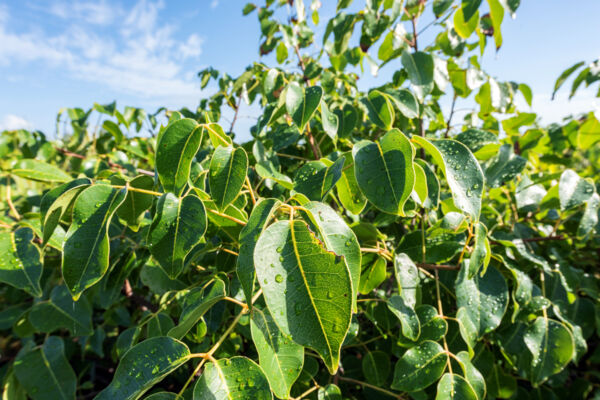
The coral sumac (Metopium toxiferum) is a poisonous tree native to the Turks and Caicos, and is commonly found throughout the islands. Contact with the tree can cause skin irritation, which in some cases can be painful and severe.
The coral sumac is known by quite a few common names, including poisonwood, Florida poisontree, hog gum, doctor’s gum, and rosewood. The tree is part of the Anacardiaceae family, which also includes other sumacs and the genera cashew, mango, poison ivy, and poison oak.
The tree is also found in southern Florida and in coastal areas throughout much of the tropical Atlantic and Caribbean.
Dangers to Humans
Coming into contact with a coral sumac tree is unpleasant for most. The tree is infamous due to its tendency to cause pain, rashes, and skin irritation in humans when touched. This delayed-type hypersensitivity response often presents as mild to severe itching, mild to severe blisters, dermatitis, and rash. Most symptoms typically take a day or more to appear.
| Coral Sumac | |
| Common names | Coral sumac Poisonwood Florida poisontree Hog gum Doctor's gum Rosewood |
| Binomial name | Metopium toxiferum |
| Global conservation status | Least concern |
| Conservation status in TCI | Unthreatened |
| Distribution in TCI | Very common |
| Maximum height | 40 feet (12 m) |
These effects are caused by the body's reaction to the sap and the urushiol—a mixture of compounds in an oily resin present on the tree's leaves and stems—that the tree produces. Urushiol is also secreted by other plants, such as poison ivy and poison oak. As such, the symptoms of an allergic reaction to coral sumac are similar to those of poison ivy or poison oak.
Unfortunately, the sap and urushiol from the coral sumac are usually invisible, which means touching virtually any part of the tree can cause a painful reaction in the body. Standing under a coral sumac when it's raining will typically transfer sufficient quantities of urushiol to cause symptoms.
The coral sumac's urushiol can be spread by touching and surface contamination, so it's important to wash the affected area as soon as possible.
Treatment After Exposure
In cases of simple skin contact with a coral sumac tree, you can take precautions to prevent or significantly reduce skin irritation.
The urushiol oily resin that the coral sumac produces does not dissolve and wash off easily with conventional hand soaps. More powerful detergents, such as liquid laundry detergent and to a lesser extent liquid dish-washing soap, can dissolve the urushiol. If you have touched a coral sumac tree, scrub the affected area with a clean cloth and a detergent that can dissolve oils. Typically, skin irritation symptoms can be avoided or managed if the contact area is cleaned within a few hours of exposure.
A common island remedy is to treat the affected areas with WD-40, which is a water displacement agent. WD-40 does effectively dissolve and displace urushiol, however, it should not be used for medical purposes and is not more effective than detergents.
If severe reactions or skin conditions occur, seek professional medical help.
History of Coral Sumac
Not everyone experiences skin irritation from touching the coral sumac. In 1946 in the Bahamas, Royal Air Force flight lieutenant W. P. U. Jackson, M.B., M.R.C.P., conducted exposure testing on 20 volunteer Royal Air Force subjects. Two developed severe reactions, 12 experienced skin irritation and blisters, and six were unaffected.
There are anecdotal accounts that a tea was made from the coral sumac in combination perhaps with other noxious ingredients for the purpose of inducing abortions. Information on this potentially highly dangerous practice is limited.
Identifying the Coral Sumac
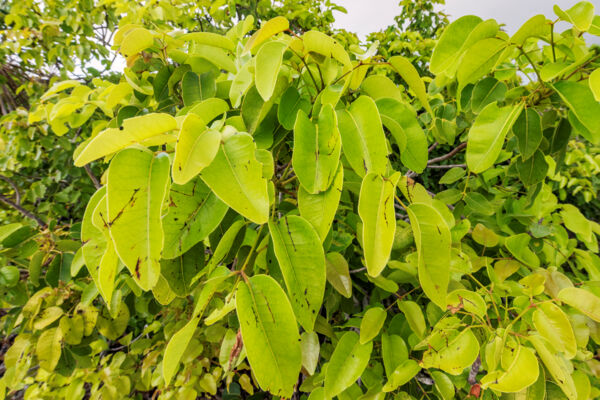
The best strategy to avoid coming into contact with coral sumac is to simply learn how to identify and avoid the tree. The leaves and bark of the tree are quite distinctive, and are typically a more verdant green than much of the surrounding vegetation. Older leaves often have small black spots. The bark is usually light grey with light reddish or sandy orange patches where the bark has recently peeled. Older trees will often have a higher concentration of reddish and orange patches. The branches and trunk sometimes have black patches of dry, hardened sap.
In the Turks and Caicos, the coral sumac tree's size can vary significantly. While people often see them as small saplings, they can reach heights of more than 40 feet (12 m) where soil depth allows. Leaf length can vary widely, from about 1.5 to 6 inches (38–152 mm). Around 4 inches (100 mm) is the norm.
Distribution in the Turks and Caicos
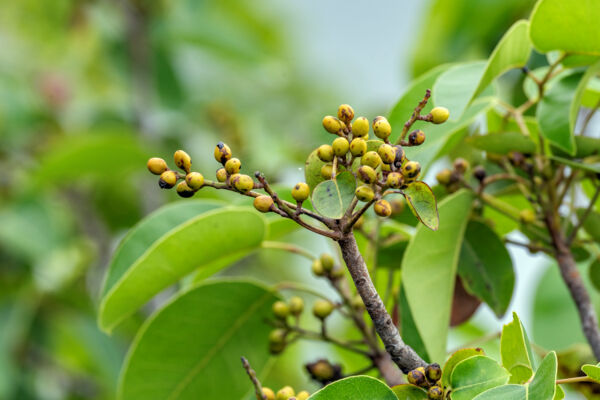
The coral sumac is found throughout the Turks and Caicos Islands, and especially in rocky coastal areas. It can be occasionally found inland, but the tree thrives in somewhat difficult conditions where other competing vegetation is limited. Examples include the transitional areas between marine environments with high salinity and the low-salinity tropical dry forest, as well as the limestone ironshore environments of areas such as Chalk Sound, where soil is limited and salinity is high.
Areas that have high densities of coral sumac trees include the extended limestone coppices on the southern side of North Caicos, Middle Caicos, and East Caicos, the Chalk Sound and Frenchman’s Creek areas on Providenciales, and many coastal areas throughout the islands.
In 2015, Tropical Storm Joaquin struck the Turks and Caicos and caused limited damage. The storm, however, did have atypical southwest wind directions, which caused unusual wind and salt burn on vegetation, including coral sumac trees, along the Chalk Sound and Frenchman’s Creek coastlines. It was quite remarkable how fast the verdant and bright green coral sumac foliage recovered, in a striking contrast to the reds and oranges of the surrounding damaged vegetation.

